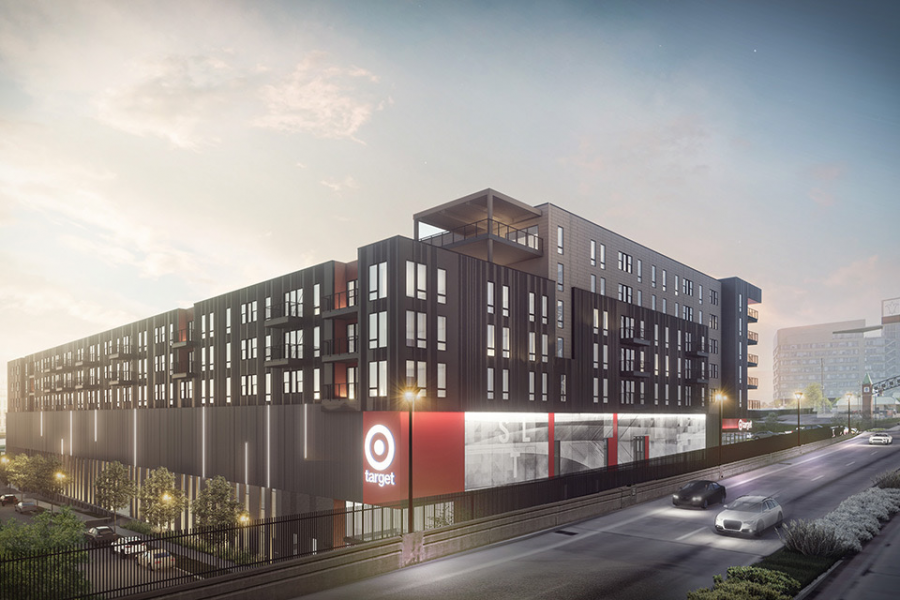Target to Come to Midtown in 2023
Sparking community conversation
The Saint Louis-based real estate company, Pier Property Group, announced on Oct. 28 that an urban-style Target will be part of the $60 million mixed-use apartment building in Midtown. The Edwin, as this project is called, is located within the 400-acre redevelopment area that is guided by SLU and SSM Health through the St. Louis Midtown Redevelopment Corporation (SLMRC).
Located between Gratiot and Papin streets on South Grand Boulevard, the building will be within walking distance of Saint Louis University’s north and south campuses. The project will be completed in the Summer of 2023, when developers say they hope to see a beneficial impact on SLU students and employees, and city residents at large.
“The city is under-retailed so this Target is great,” said executive director of the SLMRC, Brooks Goedeker. “We love the location because of the 70 Grand bus line that connects all of North City and South City to that destination there. This also signals to different international retailers that if Target wants to come to this location, they should also consider it.”
This development is the fourth addition to the Steelcote Square District plan. The six-story building features 196 apartments as well as surface-level parking and an underground garage. After negotiating with city officials, PPG developers have agreed to allocate 10% of the apartment units for affordable housing that supports lower-income tenants.
“When we think about projects in and around our redevelopment area, the affordable housing conversation comes up. The numbers worked and the developers were able to carve out a piece for affordable housing. It was a major win for the city and for the developers,” SLU Chief Financial Officer and SLMRC board member, David Heimburger said.
Another recurring conversation about new developments in the area is tax incentives. The SLMRC has the power to unilaterally grant developers tax increment financing or tax abatements for different projects to reduce the amount of property taxes owners pay over a period of 10-20 years.
According to a financial analysis filed with St. Louis Development Corporation (SLDC), the SLMRC will apply a 20-year tax abatement for The Edwin development, as they have done with others in Steelcote Square District. They will also use a sales tax exemption on construction materials after recent approval by the Board of Alderman.
“There’s just a concern that we’re prioritizing corporate welfare at the expense of our public schools and our children,” Ben Connover, 2013 SLU alumnus and an organizer with Solidarity With SLPS, said.
Solidarity With SLPS is a group of St. Louis City residents working to improve St. Louis Public Schools. The district’s primary source of funding comes from local property taxes. But according to the 2020 SLPS Comprehensive Annual Financial Report, the district lost out on $34.7 million in taxes from abated properties.
The Target store is estimated to generate $2 million in sales tax revenue annually, and employees and the tenants will also pay a 1% income tax to the city. The land’s property tax is approximately $7,000 but is expected to increase significantly after the development is completed.
“I would challenge SLU to look at their mission,” Connover said. “Are they here to prioritize business development and to subsidize corporate welfare? Or are they here to be good neighbors and a beneficial part of the community, because they have a pretty callous history on that.”
The history Connover refers to is that of Mill Creek Valley, a neighborhood which ceased to exist by 1959, and that includes land that The Edwin will be built on. Home to approximately 20,000 primarily African American residents, city officials designated a large segment of the neighborhood for clearance. Assistant professor of sociology, Christopher Prener, Ph.D., has studied urban renewal in St. Louis, saying that “this is the historical set up for our current relationship with the area”.
The story continues when SLU was gifted $1 million from a donor in 1959 to buy 22.5 acres of land—which included land from the former Mill Creek Valley—to expand the campus. Three decades later, SLU acquired additional land along Compton Avenue when public housing complexes there were in demise.
“This is a situation that had real material harm for African Americans,” Prener said. “Our relationship with Mill Creek Valley since the late 1950s has been one of very opportunistic development that only benefited student experiences.”
Heimburger and Goedeker acknowledge that residents’ views of SLU have not been positive due to this history but say their efforts with the SLMRC, including partnerships with the surrounding Tiffany and Gate District West neighborhoods and investments in the area, has made a difference.
“There is a shift now where folks in those residential communities are saying SLU has become a really good partner. We certainly want to do it differently, to do it right and not gentrify any neighborhoods,” Heimburger said. “We know we can evolve and improve but we think we’re making progress.”
Many midtowns across the country are energetic hubs for education, healthcare, jobs, services and entertainment. And Goedeker envisions the same for Midtown St. Louis in the near future.
“Target is great for students and the neighborhood. Generally [though], development on its own is not enough to address the legacy of our relationship with the Mill Creek Valley,” Prener said. “Students have no idea what they’re walking on, whether that is going to the BSC or to a soccer game or going to the new Target or living in Steelcote Lofts. That gap needs to be addressed.”
Your donation will support the student journalists of Saint Louis University.





